How to fully customize your WordPress RSS feed
Apr 20, 2025 am 06:57 AMDo you want to add content to your WordPress RSS feed?
WordPress RSS feeds display the content of your recent posts. However, by default, there is no option to customize the content for RSS source users.
In this article, we will show you how to easily add content and fully operate your WordPress RSS feed.
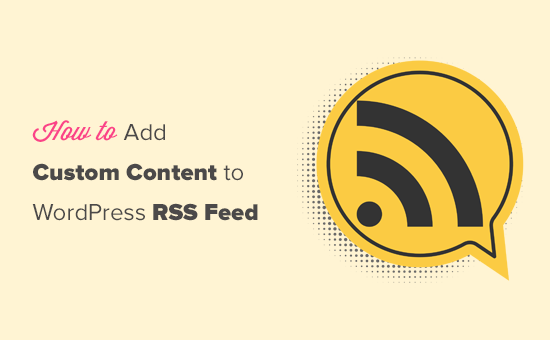
Here is a quick overview of what we will cover in this article:
- Add custom content to WordPress RSS feed (easy way)
- Use code to add content to WordPress RSS sources
- Add data from custom fields to your WordPress RSS source
- Add additional text to RSS to post title
- Add custom content to posts with specific tags or categories
- Add featured images to RSS sources
- Additional resources for customizing WordPress RSS feeds
Add custom content to WordPress RSS feed (easy way)
The easiest way to add custom content to your WordPress RSS feed is to use the All in One SEO plugin. It is the best WordPress SEO plugin on the market, allowing you to easily optimize your website SEO.
The first thing you need to do is install and activate the All in One SEO plugin. For more details, see our step-by-step guide on how to install WordPress plug-ins.
After activation, you will be prompted to set up the plug-in. Just follow the on-screen instructions or check out our guide on how to set up all-in-one SEO.
After that, you need to visit the All in One SEO ? General Settings page and switch to the RSS Content tab.
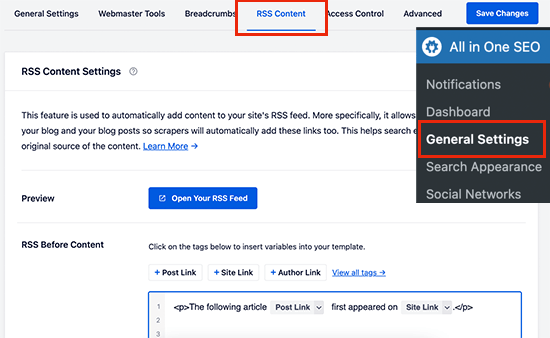
From here, you can add what you want to display before and after each RSS source project.
You can use smart tags to add links and other metadata to your custom content.
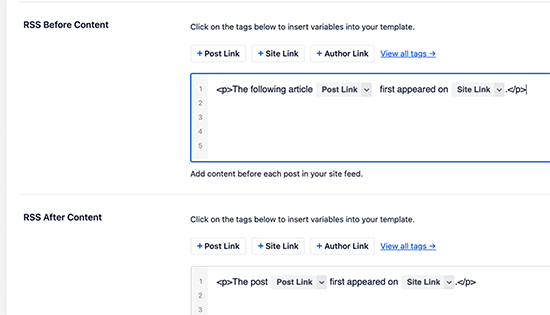
You can also use basic HTML to format your custom content in any way you like.
Once you are satisfied with the changes, don't forget to click the "Save Changes" button.
All-in-one SEO now adds your custom content to each RSS feed project.
Use code to add content to WordPress RSS sources
The first method mentioned above is the easiest way to add custom content to your WordPress RSS source. However, it adds the content to all projects in the WordPress feed.
What if you want to add content to a specific post, post in a selected category, or display custom metadata in an RSS source?
The next few steps will help you with the flexibility to add content to your RSS feed using custom code snippets. This is not recommended for beginners.
You can add these snippets directly to the theme's functions.php file. However, we recommend using the WPCode plugin as this is the easiest way to add custom code to WordPress without breaking your website.
It even contains multiple RSS snippets in its library that can be activated with just a few clicks.
Simply follow the instructions in our WordPress plugin installation guide to install and activate the WPCode free plugin.
Let's try some examples of manually adding custom content in WordPress RSS feed.
1. Add data from custom fields to your WordPress RSS source
Custom fields allow you to add extra metadata to WordPress posts and pages. However, by default, this metadata is not included in the RSS source.
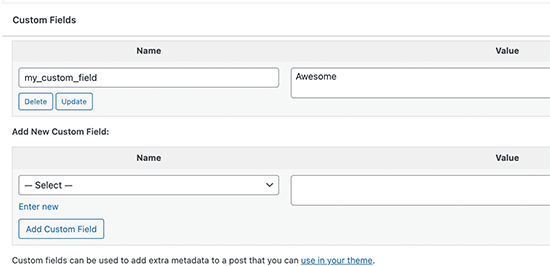
Here are snippets of code that can be used to retrieve and display custom field data in WordPress RSS sources:
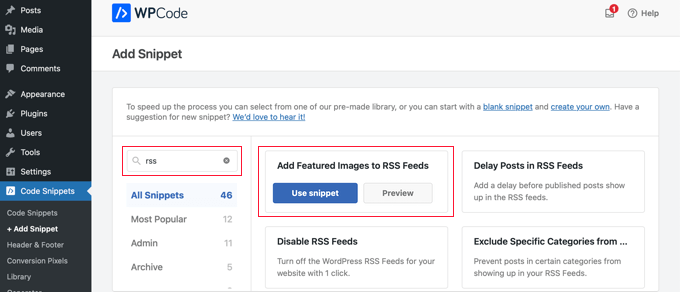
Now all you need to do is switch the Active switch to the Open position and click the Update button.
Featured images are now added to your RSS feed.
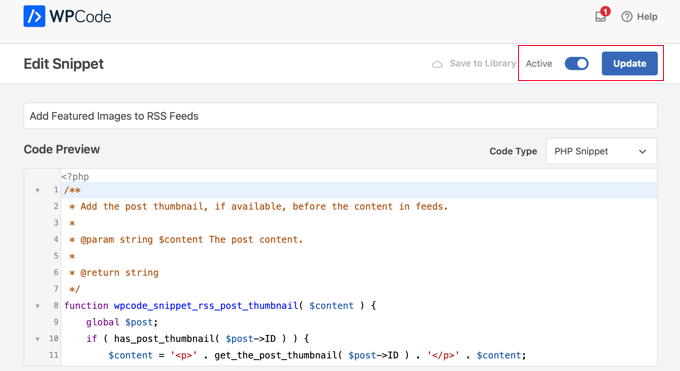
You can also manually add featured images to your RSS feed.
Here is the code you can use:
functionwpb_rsstutorial_featuredimage($content) {global$post;if(has_post_thumbnail($post->ID)) {$content= '<p>'. get_the_post_thumbnail($post->ID) .'</p>'. get_the_content();}return$content;}add_filter('the_excerpt_rss', 'wpb_rsstutorial_featuredimage');add_filter('the_content_feed', 'wpb_rsstutorial_featuredimage');add_filter('the_content_feed', 'wpb_rsstutorial_featuredimage');
Depend on
Use it with one click in WordPress
This code just checks if the post has thumbnails (featured images) and displays it with the rest of the post content
Additional resources for customizing WordPress RSS feeds
RSS feeds can be a useful tool to attract more users and keep existing subscribers engaged. Here are some resources that can help you further optimize your WordPress feed:
- Best WordPress RSS Feed Plugin
- How to Fix WordPress RSS Feed Errors
- Tips for optimizing WordPress RSS feeds
- Exclude specific categories from RSS sources
- Get content from any RSS feed to your WordPress website (autoblog)
We hope this article helps you understand how to add content to a WordPress RSS feed. You may also want to check out our guide on how to add email subscriptions to your WordPress blog, or our expertly selected best WordPress business directory plugins.
The above is the detailed content of How to fully customize your WordPress RSS feed. For more information, please follow other related articles on the PHP Chinese website!

Hot AI Tools

Undress AI Tool
Undress images for free

Undresser.AI Undress
AI-powered app for creating realistic nude photos

AI Clothes Remover
Online AI tool for removing clothes from photos.

Clothoff.io
AI clothes remover

Video Face Swap
Swap faces in any video effortlessly with our completely free AI face swap tool!

Hot Article

Hot Tools

Notepad++7.3.1
Easy-to-use and free code editor

SublimeText3 Chinese version
Chinese version, very easy to use

Zend Studio 13.0.1
Powerful PHP integrated development environment

Dreamweaver CS6
Visual web development tools

SublimeText3 Mac version
God-level code editing software (SublimeText3)

Hot Topics
 What are the mainstream public chains of cryptocurrencies? The top ten rankings of cryptocurrency mainstream public chains in 2025
Jul 10, 2025 pm 08:21 PM
What are the mainstream public chains of cryptocurrencies? The top ten rankings of cryptocurrency mainstream public chains in 2025
Jul 10, 2025 pm 08:21 PM
The pattern in the public chain field shows a trend of "one super, many strong ones, and a hundred flowers blooming". Ethereum is still leading with its ecological moat, while Solana, Avalanche and others are challenging performance. Meanwhile, Polkadot, Cosmos, which focuses on interoperability, and Chainlink, which is a critical infrastructure, form a future picture of multiple chains coexisting. For users and developers, choosing which platform is no longer a single choice, but requires a trade-off between performance, cost, security and ecological maturity based on specific needs.
 Leading the top 20 token rankings in the 2025 crypto market (Latest update)
Jul 10, 2025 pm 08:48 PM
Leading the top 20 token rankings in the 2025 crypto market (Latest update)
Jul 10, 2025 pm 08:48 PM
The top 20 most promising crypto assets in 2025 include BTC, ETH, SOL, etc., mainly covering multiple tracks such as public chains, Layer 2, AI, DeFi and gaming. 1.BTC continues to lead the market with its digital yellow metallicity and popularization of ETFs; 2.ETH consolidates the ecosystem due to its position and upgrade of smart contract platforms; 3.SOL stands out with high-performance public chains and developer communities; 4.LINK is the leader in oracle connecting real data; 5.RNDR builds decentralized GPU network service AI needs; 6.IMX focuses on Web3 games to provide a zero-gas-free environment; 7.ARB leads with mature Layer 2 technology and huge DeFi ecosystem; 8.MATIC has become the value layer of Ethereum through multi-chain evolution
 Comparison of the differences and advantages and disadvantages of USDC, DAI, and TUSD (recently updated)
Jul 10, 2025 pm 09:09 PM
Comparison of the differences and advantages and disadvantages of USDC, DAI, and TUSD (recently updated)
Jul 10, 2025 pm 09:09 PM
The core difference between USDC, DAI and TUSD lies in the issuance mechanism, collateral assets and risk characteristics. 1. USDC is a centralized stablecoin issued by Circle and is collateralized by cash and short-term treasury bonds. Its advantages are compliance and transparent, strong liquidity, and high stability, but there is a risk of centralized review and single point failure; 2. DAI is a decentralized stablecoin, generated through the MakerDAO protocol, and the collateral is a crypto asset. It has the advantages of anti-censorship, transparency on chain, and permission-free, but it also faces systemic risks, dependence on centralized assets and complexity issues; 3. TUSD is a centralized stablecoin, emphasizing real-time on-chain reserve proof, providing higher frequency transparency verification, but has a small market share and weak liquidity. The three are collateral types and decentralization
 What are the mainstream cryptocurrencies in the world? In-depth analysis of cryptocurrency in 2025 (including website)
Jul 10, 2025 pm 08:36 PM
What are the mainstream cryptocurrencies in the world? In-depth analysis of cryptocurrency in 2025 (including website)
Jul 10, 2025 pm 08:36 PM
At a time when the digital economy wave swept the world, cryptocurrencies have become the focus of attention from all walks of life with their unique decentralization and transparency. From the initial geek niche experiment to the current financial landscape with a market value of trillions, the evolution of cryptocurrencies is amazing. It not only brings innovations in underlying technologies, but also gives birth to countless innovative applications, which are profoundly affecting all aspects of finance, technology and even social governance.
 Which chain does Dogecoin DOGE belong to? Does Dogecoin belong to the Binance Chain?
Jul 10, 2025 pm 08:39 PM
Which chain does Dogecoin DOGE belong to? Does Dogecoin belong to the Binance Chain?
Jul 10, 2025 pm 08:39 PM
Recently, the discussion in the digital asset field has remained hot. Dogecoin DOGE, as one of the most popular focus, has become a question that many people have explored. Where does it "settling down"? What is the relationship with the current leading trading platform, Binance? To answer these questions, we need to conduct in-depth analysis from the two dimensions of the underlying technical logic of digital assets and the platform ecology, rather than just staying in appearance.
 Meme Coin Mania: The Power of Dogecoin, Shiba Inu and Community Hype
Jul 10, 2025 pm 07:48 PM
Meme Coin Mania: The Power of Dogecoin, Shiba Inu and Community Hype
Jul 10, 2025 pm 07:48 PM
The rise of meme coins reflects the key role of community power and social media influence in the cryptocurrency market. 1. Dogecoin was originally a satirical joke and was born in 2013; 2. Driven by tweets from celebrities such as Elon Musk, the attention soared; 3. The market value once reached tens of billions of dollars, becoming a mainstream digital asset. Shiba Inu Coin is positioned as a "dogcoin killer" and has rapidly risen through community-driven strategies, building a decentralized exchange ShibaSwap, and relies on low-priced units to attract a large number of users to participate. Its success also depends on circulation guarantees on mainstream platforms such as Binance, Coinbase, and OKX. The core driving forces of meme coins include: 1. Viral transmission mechanism, rapid spread of information; 2. Enhanced sense of community belonging
 What are the most promising cryptocurrencies? Can ordinary people make money by buying cryptocurrencies?
Jul 10, 2025 pm 08:24 PM
What are the most promising cryptocurrencies? Can ordinary people make money by buying cryptocurrencies?
Jul 10, 2025 pm 08:24 PM
Whether ordinary people can make money by participating in the cryptocurrency market depends on multiple factors, and opportunities and risks coexist. This article introduces mainstream projects such as Bitcoin, Ethereum, Solana, BNB and Cardano. The highlights are market consensus, smart contract ecosystem, high-performance public chains, platform resource support and technical rigor; potential opportunities include high growth potential, technological innovation and low entry threshold, but risks are also significant, such as large price fluctuations, technical complexity, security issues and regulatory uncertainty; for beginners, it is recommended to follow the following steps: 1. Independent research (DYOR); 2. Select a reliable trading platform; 3. Complete identity verification; 4. Small batch investment; 5. Learn to keep assets safely. Overall, the cryptocurrency market has potential, but it needs to be treated with caution
 Ethereum's leap in scalability: How Layer 2 solutions shape the future
Jul 10, 2025 pm 08:00 PM
Ethereum's leap in scalability: How Layer 2 solutions shape the future
Jul 10, 2025 pm 08:00 PM
Ethereum Layer 2 (L2) expansion solution significantly improves efficiency and reduces costs by processing off-chain transactions. The main solutions include 1. Rollups (optimistic Rollup and zero-knowledge Rollup) performs computing in L2 and L1 storage data; 2. The state channel is suitable for off-chain high-frequency interaction; 3. The side chain provides independent blockchain and L1 connection; L2 makes micro payments and high-frequency transactions possible through batch processing of transactions and reducing Gas fees; at the same time, it empowers the application ecosystems such as DeFi, NFT and blockchain games, and is integrated by mainstream platforms such as Binance and Ouyi to achieve rapid asset transfer and promote the development of crypto asset liquidity.






